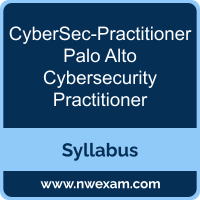 A great way to start the Palo Alto Networks Certified Cybersecurity Practitioner preparation is to begin by properly appreciating the role that syllabus and study guide play in the Palo Alto CyberSec-Practitioner certification exam. This study guide is an instrument to get you on the same page with Palo Alto and understand the nature of the Palo Alto CyberSec-Practitioner exam.
A great way to start the Palo Alto Networks Certified Cybersecurity Practitioner preparation is to begin by properly appreciating the role that syllabus and study guide play in the Palo Alto CyberSec-Practitioner certification exam. This study guide is an instrument to get you on the same page with Palo Alto and understand the nature of the Palo Alto CyberSec-Practitioner exam.
Our team of experts has composed this Palo Alto CyberSec-Practitioner exam preparation guide to provide the overview about Palo Alto Cybersecurity Practitioner exam, study material, sample questions, practice exam and ways to interpret the exam objectives to help you assess your readiness for the Palo Alto CyberSec-Practitioner exam by identifying prerequisite areas of knowledge. We recommend you to refer the simulation questions and practice test listed in this guide to determine what type of questions will be asked and the level of difficulty that could be tested in the Palo Alto CyberSec-Practitioner certification exam.
Palo Alto CyberSec-Practitioner Exam Overview:
| Exam Name | Palo Alto Cybersecurity Practitioner |
| Exam Number | CyberSec-Practitioner |
| Exam Price | $150 USD |
| Duration | 90 minutes |
| Number of Questions | 75 |
| Passing Score | 860 on a scale of 300 to 1000 |
| Exam Registration | PEARSON VUE |
| Sample Questions | Palo Alto CyberSec-Practitioner Sample Questions |
| Practice Exam | Palo Alto Networks Certified Cybersecurity Practitioner Practice Test |
Palo Alto CyberSec-Practitioner Exam Topics:
| Section | Weight | Objectives |
|---|---|---|
| Cybersecurity | 19% |
- Identify the components of the authentication, authorization, and accounting (AAA) framework - Categorize techniques used by malicious actors as defined by the MITRE ATT&CK framework - Explain the concept of Zero Trust and define its key principles
- Identify and describe the characteristics of an advanced persistent threat (APT)
|
| Network Security | 19% |
- Describe key characteristics of Zero Trust Network Access (ZTNA) - Explain the function of stateless firewalls and next-generation firewalls (NGFWs) - Explain the purpose of microsegmentation - Explain the purpose and function of common network security technologies
- Explain the limitations of signature-based network protection |
| Secure Access | 14% |
- Define and explain Secure Access Service Edge (SASE) and differentiate from Secure Service Edge (SSE) - Identify challenges related to confidentiality, integrity, and availability of information and applications
- Explain the security function of common technologies
- Describe the purpose of Software-Defined Wide Area Networking (SD-WAN) solutions
|
| Cloud Security | 20% |
- Identify and describe major cloud architectures and topologies - Identify and describe major challenges related to cloud security
- Identify and describe technologies used to secure cloud environments (e.g. CSPM, CWPP) |
| Endpoint Security | 15% |
- Identify and explain Indicators of Compromise (IOCs) - Explain the limitations of signature-based anti-malware software - Explain the concept of User and Entity Behavior Analytics (UEBA) - Explain endpoint detection and response (EDR) and extended detection and response (XDR) - Explain Behavioral Threat Prevention - Identify and describe cybersecurity threats mitigated by the following endpoint security technologies
- Explain the features and functionality of Cortex XDR |
| Security Operations | 13% |
- Identify and describe key characteristics of threat hunting - Explain the process and outcomes of incident response - Explain the functions of a security information and event management (SIEM) platform - Explain the functions of security orchestration, automation, and response (SOAR) - Explain the function of an Attack Surface Management (ASM) platform - Explain the features and functionality of Cortex solutions
- Identify and describe the services provided by Unit 42 |
Palo Alto CyberSec-Practitioner Exam Description:
The Palo Alto Networks Certified Cybersecurity Practitioner certification is for individuals wanting to validate their understanding of cybersecurity and explore the Palo Alto Networks portfolio of solutions and related technologies. It is designed for those interested in technical and non-technical roles in cybersecurity and will validate knowledge and basic application of solutions in the areas of cybersecurity, network security, secure access, endpoint security, cloud security, and security operations.
